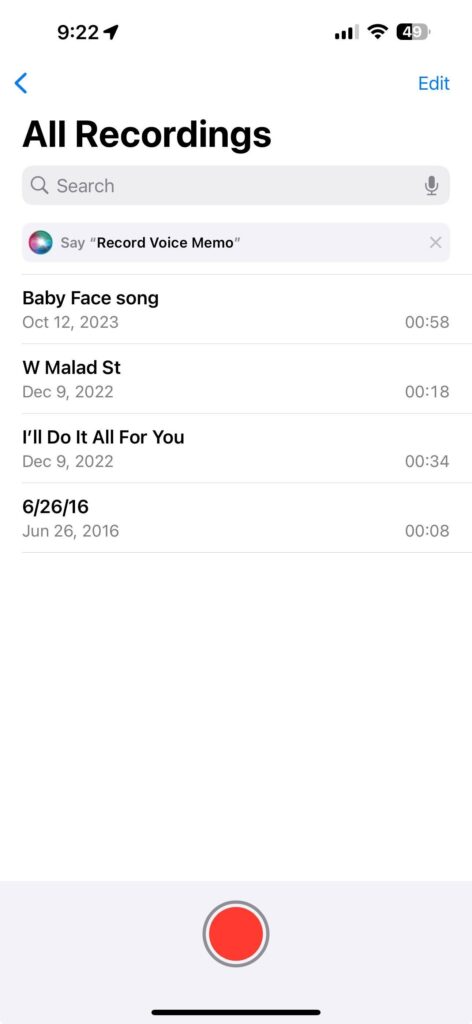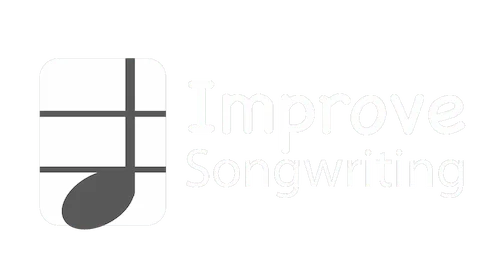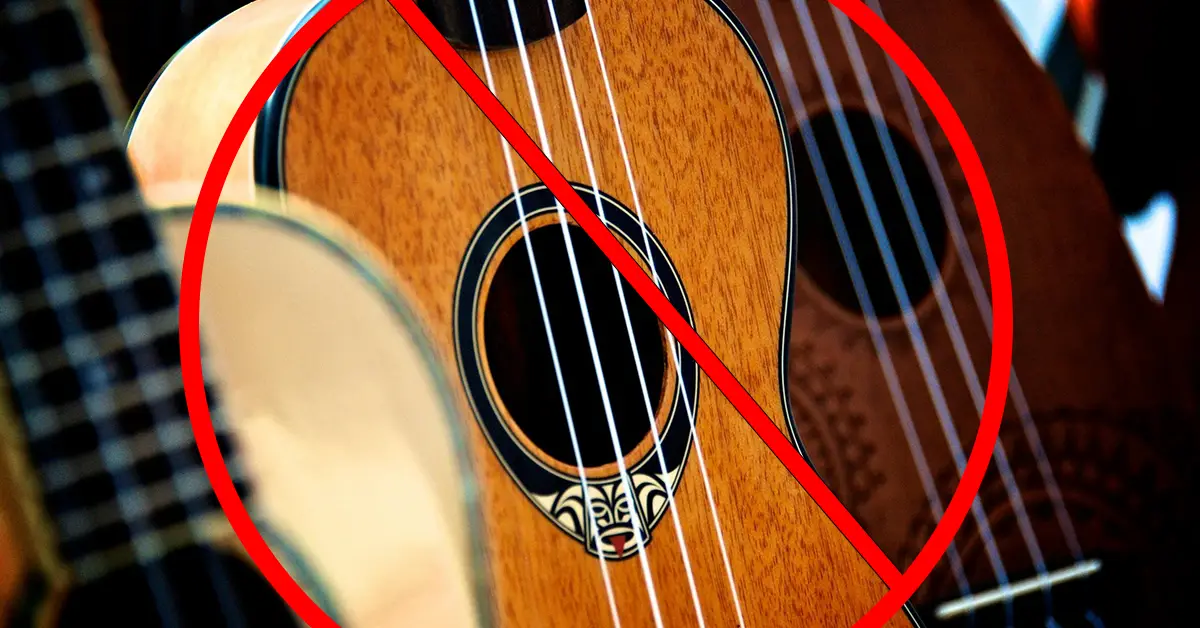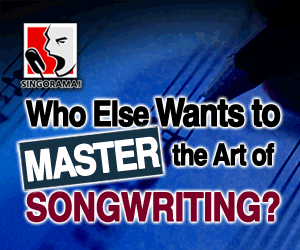Look, I’ll be the FIRST to admit that it’s really helpful to play a musical instrument while you’re writing a song! However, when I first got interested in making songs, I only had my singing voice, a trusty G4 iMac, a headphone mic, and GarageBand… and that didn’t stop me from being musical and creative!
The good news is, many of the greatest songs in history didn’t start on a piano or guitar – they began as ideas, melodies, or lyrical concepts on the page or a recording device. While having an instrument can certainly help you develop or arrange the song you’re working on, it’s by no means a requirement to kickstart the creative process!
In fact, writing without an instrument can sometimes free you from technical limitations, allowing you to focus on important bigger-picture things like theme, melody, lyrics, or the overall emotion of the piece.
In this guide, I’m going to share 5 tips for how to write a song without an instrument – from start to finish – covering everything from developing lyrics and melody to capturing rhythms. Let’s do it!
Improve your songwriting by mastering piano.
$49
ONLY
Writing Songs Without Instruments
These days, songwriters are seeing a whole new crop of tech and creative tools, from mobile apps to song idea generators to generative AI. All of these represent new workflows for creating without an instrument.
Whether you’re humming a melody into your phone, mapping out rhythms in your DAW, or doing it old-school and jotting down lyric ideas in a notebook, you’ve got a ton of options here. Read on for 5 ways you can work on your next opus… sans instrument!
Tip 1: Find Your Inspiration
We all know there’s a technical side to songwriting, what with music notation and scales and intricate rhythms. But what REALLY makes music resonate with actual humans is the idea underpinning your work. Effective songwriting is all about capturing emotions, ideas, and stories in a way that your listeners can relate to!
So, believe it or not, eschewing a musical instrument leaves you free to explore your inner thoughts and find the compelling song ideas in them. It can actually be easier to develop lyrical phrases and melodies when the primary tool at your disposal is just your brain!
How can you find inspiration? I’ve got a few suggestions!
A) Develop Ideas from Everyday Life
Inspiration often strikes when we least expect it: while walking around outside, during a conversation with an acquaintance, or even during a quiet moment sitting on your back patio.
Take time to actively observe the world around you. Do some people watching, journal about your day, or consider the emotions behind the entertainment you consume, from television to movies to podcasts. Even a single word or phrase could be the seed you need for an entire song.
I recommend keeping a notebook or using your phone to capture these ideas whenever they come to you, so you can revisit them when it’s time to start writing!
B) Use Voice Memos or Apps
This is one I’ve done for years!
If you’ve got a melody or lyrical phrase forming in your head, don’t let it slip away! Use the voice memo app on your phone to capture these germs of an idea, including a hummed melody, an interesting rhythm, a novel lyrical hook, or all of the above. If you can sing or hum, you can memorialize your new song.

This ONE habit allows you to build an ever-growing bank of good ideas for songs, whether you’re just temporarily away from your instrument or you don’t play one at all. Some of the best songs come from something you hummed to yourself while chopping garlic or waiting for the light to turn green!
C) Tap Into Your Emotions
Songwriting is a deeply emotional process. Without an instrument to distract you, it’s easier to tap into your feelings and write about them freely.
So take that personal heartbreak, that moment of triumph, that narrative idea, or whatever else you’re feeling deeply right now, and let your emotions guide you into new lyrics and melodies. A lot of the most powerful and memorable songs come from raw emotion – so don’t hesitate to dig deep and explore what you’re feeling in the moment!
Tip 2: Focus on Lyrics First
I love messing around with musical motifs on an instrument as I write a new song.
But with that said, I think the act of physically holding a guitar or sitting up at the piano can actually discourage you from writing lyrics, because you’ve got something there to distract you. In the perennial struggle of what to focus on, having an instrument around may keep you from choosing. (Speaking of, check out my guide discussing whether to write lyrics or music first for more on this topic!)
There’s a freedom in crafting words for a song before you ever worry about chord progressions or melodies. Lyrics can set the tone and direction for a song, allowing the right melodies and rhythms to follow naturally.
So, what does this look like in practice? Here are a few thoughts!
A) Start with a Strong Lyrical Concept
Every great song begins with an idea of some kind. This could be a story, a feeling, or some kind of message you want to convey – but it needs to be tangible and relatable. In “Can’t Be Really Gone,” Tim McGraw opines about how she can’t have really left him, because her favorite hat is still hanging on the hook… and she never leaves without it.
Ask yourself questions like: What do I want the listener to feel? Is there a story I want to tell? What message am I trying to get across?
It could be something deeply personal or a broader theme that anyone can relate to. Often, the best songs are a little bit of both – maybe a personal story or observation that ties into a universal theme that lots of people have experienced. Once you have your concept, you can start building your lyrics around it, creating imagery and turns of phrase to support your idea!
B) Experiment with Lyric Writing Techniques
When you’re writing lyrics, think about the ways you can use language to paint vivid pictures in the listener’s mind. A few key techniques to keep in mind include:
- Imagery and Metaphor: Powerful imagery can make your lyrics stand out. Compare emotions to tangible objects or actions: love is like a wildfire, or sadness is a rainy day. Metaphors can make your lyrics more relatable and impactful.
- Storytelling: Some of the most memorable songs tell a story. Think of classic examples in country, folk, or pop music, where each verse progresses a narrative. Johnny Cash did this a lot, as did the Beatles! Whether it’s a love story, a journey, or a struggle, storytelling can give your song depth and make it more engaging.
- Structure Tips: Focus on creating a clear song structure. A typical format will usually be something like verse – chorus – verse – chorus – bridge – chorus. Keep your verses consistent in length and rhyme scheme, and make the chorus the emotional or thematic high point of the song.
- Rhyme Schemes: While you don’t have to stick to strict rhymes for every song you write, using a rhyme scheme can give your song more structure and flow. Popular options include AABB (paired rhymes), ABAB (alternating rhymes), or free verse with no rhyme at all. Without being constrained by chords, feel free to experiment with how the words sound together and how they lead into one another.
You can jot down any or all of these ideas without any instrument or music in the picture. If you’re focused on lyric writing, then brainstorm compelling imagery, consider the stories you want to tell, or experiment with song structure and rhyme schemes on your phone or in your notebook!
C) Add Rhythm to Your Lyrics
One key benefit of NOT using an instrument is the freedom to focus on rhythms for your lyrics. Since you’re not tied to a set tempo or chord progression yet, you can let the words themselves shape the sound and rhythm.
Try tapping out a beat with your hands or feet as you recite your lyrics to find a natural flow. The rhythm can inform how you arrange the words, where you place emphasis, and how the lyrics fit into the overall structure of the song.
Short, punchy lines can create a sense of urgency, while longer, flowing lines can offer a more reflective or emotional feel. Play around with how your lyrics sound spoken or sung, and don’t be afraid to rearrange them until the rhythm feels exactly right!
Tip 3: Make Your Melody
Creating a melody without an instrument might seem like an impossible challenge, but like with lyric writing, this can actually free you from the constraints of chord progressions and scales!
If you have a decent singing voice – or you can hum or whistle – then you can craft a melody on the fly. Here are some of my favorite ways to do it!
A) Sing or Hum Melodies
One of the simplest ways to start developing a melody is just to sing or hum. If you have any words to go off of, you can let them guide the pitch and flow of your melody. But it’s also possible to experiment with different ideas for a melody with no other elements of a song involved!
Try different approaches. Sometimes, singing your lyrics will lead you to a melody naturally, while other times, humming can give you a stronger sense of where the melody should go. Don’t be afraid to try different things and let your voice take the lead. If a melody starts to emerge, record it using a voice memo app (like I mentioned earlier) so you can revisit it and refine it later.
A word of warning: do NOT overthink this process! You can simply begin with a simple line of words, or an idea for a song in a certain genre, and then go from there. The beauty of singing or humming without an instrument is that you’re not limited by keys, chords, or specific notes – you can simply follow the melody wherever your voice takes you.
B) Use Your Voice as an Instrument
I know… the whole point of this article is to not use ANY instrument, but hopefully we can let this one slide… Right?
The thing is, your voice can be an incredibly versatile instrument. Even without accompaniment from musical instruments, your voice can convey an enormous range of emotions across an even wider range of pitches and notes.
So, as you develop your melody, experiment with different vocal techniques to see how they influence the overall feel of the song. For example:
- Change pitch: Try singing your lyrics in different keys or pitches to see which version best captures the emotion you’re aiming for.
- Explore dynamics: Adjusting the volume and intensity of your singing can add layers to your melody. Soft, whispery tones can create a sense of vulnerability, while stronger, more forceful notes can add drama or urgency.
- Vary the rhythm: Without an instrument, you have the freedom to play with the rhythm of the melody. Try changing up the pacing or adding pauses for emphasis.
Each of these vocal techniques can shape the melody in unique ways, so use your voice to experiment and find what works best for your song.
C) Get Help From Technology
Even if you’re writing without an instrument, that doesn’t mean you can’t use technology to help refine your melody. I happen to love technology to help drive creativity.
Fortunately, there are many fancy new tools available that can help you shape your ideas into a structured song. Here are some examples:
- Hookpad: Hookpad is a songwriting tool that helps you sketch out melodies and chord progressions. While it’s often used with instruments, it can still be a helpful tool for visualizing the flow of your melody.
- Splice or other music software: Platforms like Splice offer loops and samples that can inspire your melody creation. You can use these resources to get a feel for different melodic styles and rhythms (and even give yourself some music to riff off of, without an instrument involved).
- GarageBand or other DAWs: If you’re more comfortable working with digital audio tools (which I HIGHLY recommend), then apps like GarageBand, Logic, Pro Tools, or Ableton will allow you to hum or sing right into the app and create basic backing tracks for your melodies. You can start simple and build as you go.
Technology can be a fantastic tool for songwriting, including with melody – and it can offer a way to visualize and hear your melodies more clearly as they develop. I started out making music with GarageBand and crafted melodies with virtual instruments like piano, as well as my own voice!
This method is still one of my favorite ways to stumble across new ideas for melodies.
Tip 4: Create a Rhythm or a Beat
Even without an instrument, you can still develop the rhythmic foundation of your song wherever you happen to be. Rhythm plays a crucial role in how your melody and lyrics come across in a song!
In addition, your song’s rhythm will establish its pace and energy, helping to convey mood, movement, and intensity. Even if you don’t have a drum kit or metronome at hand, that doesn’t mean you can’t create a strong rhythmic pulse. In fact, using body percussion or digital tools can allow you to explore rhythms in more intuitive and creative ways!
I’m not a gifted drummer by any means, but I do love rhythm and appreciate how important it is for songs in any genre, from rap to EDM to folk. So, here’s how you can create your own!
A) Try Beatboxing or Clapping
One of the most accessible ways to create rhythm without an instrument is to use your own body as a rhythmic tool. Beatboxing or clapping out a rhythm can help you establish the basic pulse of your song. You can tap your feet, snap your fingers, or even use your hands to clap different rhythms. Experiment with these simple body percussion techniques:
- Clapping: Start by clapping a steady 4/4 beat, which is the most common time signature in popular music. Once you’re comfortable, try adding more complexity by incorporating syncopation, where you emphasize off-beats or create unexpected accents.
- Tapping: Tap your foot or hand to keep a steady beat while you sing or hum your melody. This can help you lock in the tempo and feel of your song.
- Beatboxing: If you’re feeling adventurous, try using your voice and mouth to create percussive sounds. Beatboxing allows you to simulate drum patterns and add a groove to your song even without instruments. Focus on basic beats to start—simple kick, snare, and hi-hat sounds can give your song a solid rhythmic foundation.
These methods can give your song a tangible sense of rhythm and drive, making it easier to envision how the melody and lyrics will fit within the overall groove of the track.
B) Embrace Body Percussion as a Tool
You can expand beyond clapping or tapping by using your entire body to generate rhythm. For example, slapping your chest, thighs, or other surfaces can create deeper, more resonant sounds. Experiment with different parts of your body or even items around you to mimic the percussive elements of drums or other instruments.
Body percussion can add dynamic layers to your rhythm. Try alternating between softer, quieter taps and louder, more forceful hits to create a rhythmic contrast. This can help build tension and release in your song, giving it a more dynamic structure.
In the end, you may find this type of percussion interesting enough to use it in the final product!
C) Use Rhythm Apps
If body percussion or clapping doesn’t feel intuitive, you can always turn to technology to help you create a beat. There are many rhythm-based apps and digital tools available that can help you map out the rhythmic elements of your song. Here are a few popular options:
- Groovebox: The Groovebox app allows you to create beats and rhythms with an easy-to-use interface. You can layer drum patterns, adjust tempos, and experiment with different grooves that fit your song’s mood. It’s ideal for quickly crafting rhythm loops without needing any musical instruments.
- GarageBand: If you want more control over the rhythmic elements of your song, GarageBand provides a range of virtual instruments, including drum kits, loops, and samplers. You can experiment with different beats and rhythms, even recording your own beatboxing or body percussion to add a personal touch to the song.
- Metronome Apps: If you want to lock in a specific tempo for your song, using a simple metronome app can help. This keeps you on track and ensures that your rhythm remains steady throughout the song.
As you experiment with rhythm, think about how the beat can support the emotion and energy of your song. A slow, steady rhythm might work best for a ballad or introspective song, while a faster, more syncopated beat could bring energy and excitement to an upbeat track.
By exploring rhythm creatively and using both body percussion and technology, you can develop a strong rhythmic foundation for your song, even without an instrument! Let your imagination run wild and mess around with different beats and grooves until you find one that can serve as the glue for your melody, lyrics, and accompaniment!
Tip 5: Collaborate with Others
Once you’ve developed your song’s lyrics, melody, and rhythm, you can actually take it to the next step by collaborating with other musicians or producers! In fact, if you’re interested in this because you don’t know how to play an instrument, collaboration is probably the single most important step in turning your initial idea into a complete, fully produced song.
After you create the foundation of your song without an instrument, bring others into the process! That might include musicians, producers, or even other songwriters.
A) Collaborate with Musicians
If you don’t play an instrument but want your song to come to life, consider working with a musician who can fill in those gaps for you!
You can collaborate with guitarists, pianists, drummers, bass players, and even singers who can translate your vision of a melody and rhythm into chord progressions, harmonies, and full arrangements. Just remember that working with someone else requires a lot of good communication.
Here’s how you can effectively collaborate with musicians:
- Share recordings of your melody: Use any voice memos or recordings you’ve made to communicate your ideas clearly. This gives the musician a starting point and a sense of the song’s direction.
- Explain the song’s mood and energy: Be clear about the emotion and tone you’re aiming for with your song. Whether it’s a soft, acoustic ballad or an upbeat, energetic track, explaining this to the musician will help them find the right accompaniment. Sometimes, sharing a “reference track” that your song is similar to can help you convey your vision for the song.
- Be open to suggestions: No two people are the same, and that holds true for musicians too. Because everyone has different musical preferences and experience, other musicians may suggest chord progressions or rhythmic ideas that you wouldn’t have thought of. Stay open-minded and see where their expertise can take your song!
B) Share Your Ideas with Producers
Producers or engineers are great collaborators when you want to build out your song into a fully produced track. Whether you’re working with a “bedroom producer” or someone more seasoned, these talented people can help you add layers of instrumentation, solid beats, and pro-level production effects that make your song shine.
When sharing your ideas with a producer:
- Provide detailed notes: Along with your vocal recordings, give the producer clear notes on how you envision the final track. What kind of instruments do you imagine? Do you want the song to have a raw, acoustic feel or a more polished, electronic sound? The more detail you can give, the better they can understand your vision.
- Use reference tracks: If you’re not sure how to explain the sound you’re going for, be sure and give the producer some reference songs with a similar vibe or energy. Like with musicians, this gives them a clear picture of what you’re aiming for and helps guide their production choices.
As a competent songwriter and musician, I still find myself struggling to make fully-produced songs that turn out how I want them to in my DAW. Whatever gaps you have in your skillset, there’s no shame in finding someone out there who can fill them!
C) Use Remote Collaboration Tools
Thanks to technology, collaboration doesn’t have to be limited to in-person sessions anymore. Many songwriters can collaborate remotely using online platforms. Here are some tools you can use to collaborate online:
- Send files back and forth: You can easily send voice memos, lyric sheets, and notes to musicians or producers through email or cloud platforms like Google Drive, Dropbox, or WeTransfer. They can send back instrumental tracks or suggestions for changes. I personally use Google Docs constantly with my brother to collaborate on the lyrics to a song remotely.
- Use collaboration apps: There are online platforms like Splice and Soundtrap where musicians, songwriters, and producers can work together on projects in real time. These tools allow you to exchange ideas and build a song together, even if you’re in different locations – and one of you doesn’t have an instrument handy!.
- Try virtual studios: Some musicians and producers offer virtual studio sessions where you can discuss ideas, share feedback, and create a song together using video calls and screen-sharing tools. This provides a more interactive experience and helps you turn your vision into the final product you’re looking for.
Ultimately, whether you’re working with musicians or producers, the goal of collaboration is to take the seed of your initial song idea and make it bloom… aurally speaking. I also want to point out that you can try to find people to collaborate with for free, maybe by bartering skills, or you can find talented people who charge for their services, but help you get where you’re going much faster!
Wrap-up: Write Songs Without an Instrument
Writing a song without an instrument can be liberating, because it allows you to focus on other important elements of your song besides music, including the theme, hook, rhythm, and melody. See how far you get just by drawing inspiration from your surroundings, crafting meaningful lyrics on your phone or notepad, and experimenting with melody and rhythm using your voice and hands.
You really CAN create a fully fleshed-out song without ever picking up a guitar or sitting at a piano! Trust your instincts and see what you’re made of. Lastly, remember that so many great songs started with nothing more than the hint of a melody in someone’s head!
Side note: If this article encourages you to work on a new song without needing an instrument, that’s fantastic and I applaud you. But at the same time, if you’re not using an instrument because you don’t know how to play one, I encourage you to give it a try. It’s incredibly worthwhile for your songwriting skills to know an instrument like piano to experiment with musical ideas, come up with an accompaniment, and ultimately, to record your own song idea! See below for a great way to learn piano.
If you want to get better at writing memorable music that resonates, I recommend that you get familiar with an instrument like piano. The more you know about how great songs are constructed sonically, the easier it will be for you to create a masterpiece yourself. Check out Piano for All below to get started!
Improve your songwriting by mastering piano.
$49
ONLY


![How Long Should a Song Be? [Radio, Streaming, and Social!]](https://improvesongwriting.com/wp-content/uploads/2023/05/How-Long-Should-a-Song-Be-440x264.jpg)






